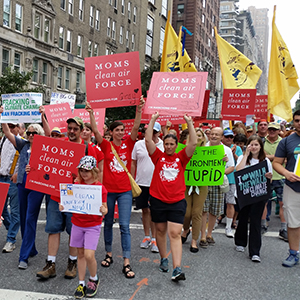Date: March 2025
To: Honorable Lee Zeldin Administrator US Environmental Protection Agency
Re: Maintaining Critical Protections Against TCE Health Risks under TSCA
Dear Administrator Zeldin:
The undersigned 124 community, environmental, public health, and other organizations from across the United States write to urge EPA to reinstate its Toxic Substances Control Act (TSCA) trichloroethylene (TCE) final rule, currently on hold, and avoid a protracted delay in implementation that will expose countless Americans to TCE’s serious risks of harm, including multiple cancers and Parkinson’s disease.
The bipartisan Lautenberg Chemical Safety Act of 2016 strengthened TSCA, the nation’s principal law for addressing unsafe chemicals. Its enactment was supported by an overwhelming majority of Republicans and Democrats, including you as a Member of Congress, along with the U.S. chemical industry.
Longstanding Concerns about TCE Health Risks and Contamination
TCE is a highly volatile solvent with many high-exposure uses, including in metal degreasing, spot removers, paints and coatings, shoe polish, adhesives and sealants, hobby kits and cleaning products for automobile brakes and other parts. TCE has for decades been notorious for contaminating drinking water supplies across the United States: 18.4 million Americans are known to be exposed to TCE from 426 drinking water systems in 43 states. TCE is a contaminant at over 50 percent of federal Superfund sites.
TCE’s health effects are numerous and well-documented and have been shown to occur at very low levels of exposure. Following brief exposures, TCE causes fetal cardiac defects which have life-long impacts and autoimmunity, in which the body’s immune system mistakenly attacks its own healthy tissues and organs. Long-term exposure has been shown to cause kidney and liver cancer and non-Hodgkin lymphoma and is associated with leukemia, breast cancer, as well as Parkinson’s disease and non-cancer liver and kidney disease. TCE also breaks down into vinyl chloride, which can be even more carcinogenic to the liver.
TCE contamination is widespread at military bases, where families of service members have suffered serious health effects linked to TCE exposure. Because of the extensive and serious harm (including death) experienced by members of the military and their families at Camp Lejeune in North Carolina, Congress included the Camp Lejeune Justice Act of 2021 in the bipartisan Honoring our PACT Act. This law authorizes expedited resolution of claims against the U.S. for harms related to TCE-contaminated drinking water at the base. The federal government is expected to pay these families more than $20 billion (per the Congressional Budget Office).
Numerous communities across the country have experienced similar harm from TCE contamination, including Woburn, Massachusetts; Franklin, Indiana; Tucson, Arizona; Rochester, New York; Piketon, Ohio; Newark, New Jersey; and Wichita, Kansas. Your former Long Island district abuts a six-square-mile underground TCE plume in an aquifer centered around Bethpage Community Park, where additional toxic chemical-filled drums were found just last year.
No family should experience the pain that these communities have endured. And taxpayers should not bear the costs associated with a chemical that is too toxic to use safely.
Reducing TCE Health Risks under TSCA
One of EPA’s first tasks under the 2016 TSCA amendments was to evaluate the risks of 10 widely-used chemicals, including TCE, that were long known to cause serious health effects. During the first Trump administration, EPA conducted risk evaluations determining that all 10 chemicals present unreasonable risks to health.
As required by TSCA, EPA then issued risk management rules for five of these chemicals (TCE, asbestos, methylene chloride, perchloroethylene (PCE) and carbon tetrachloride). These rules provide important health protections to millions of American workers, first responders, fenceline communities, and consumers.
EPA’s 2020 risk evaluation for TCE made findings of unreasonable risk to workers and consumers for 52 out of 54 known TCE uses. In recognition of its serious health threats, EPA determined that the only way to address these risks was to phase out use of the chemical. Accordingly, the TCE risk management rule imposes broad prohibitions on TCE manufacture, processing and use while providing several industries with lengthy periods (twenty to fifty years for some) to phase out TCE use and transition to safer substitutes.
To protect workers during those extended phaseout periods, the rule also requires employers to implement controls that limit occupational exposures to TCE. Responding to industry concerns about the feasibility of the controls in the proposed rule, the final rule significantly eased those requirements. EPA originally proposed an exposure limit of 1.1 parts per billion (ppb), which was necessary to protect against the unreasonable risks of birth defects and immune effects at very low doses found in the agency’s risk evaluation. However, the final rule raised this limit to 200 ppb, a level 180 times less protective than the proposed limit. While affording relief to industry, we believe this unnecessarily weakens the rule’s health protections and urge you not to weaken the rule further.
By the agency’s own estimate, the TCE rule will protect more than 85,000 workers and consumers across the country and produce more than $20 million in health benefits from reduced cancer incidence alone. EPA did not quantify the benefits from reduced fetal heart malformations and immune system toxicity, which are expected to be even greater.
Delay in Implementing TCE Rule
Unfortunately, due to recent steps taken by EPA, the TCE rule did not take effect on January 16, 2025, as specified in the rule, and is now on hold.
As promulgated by EPA on December 17, 2024, the TCE rule set an effective date of January 16, 2025. However, on January 13, 2025, a divided panel of the Fifth Circuit Court of Appeals issued a temporary administrative stay of the rule (without considering opposition briefs or making any decision on the merits of the stay request). The stay applied to the entire rule even though it was sought by one small industry segment (battery separators) of the many sectors subject to the rule and the rule gives the battery separator industry 20 years to phase out TCE.
EPA then published a Federal Register notice on January 28, 2025, stating that, because of the stay, the rule “never went into effect” and was subject to the President’s Executive Order “freezing” final regulations without pre-January 20, 2025, effective dates. 90 Fed. Reg. 8254. The notice states that this freeze will continue until at least March 21 and could be extended well beyond that date.
To avoid this alarming prospect, we strongly urge you not to extend the delay of the rule’s effective date. Too many communities have already been harmed by TCE, and prompt implementation of EPA’s rule is needed to protect millions of Americans from serious health risks. For EPA to instead leave the stay in place and undo or rework the TCE rule would be a misallocation of EPA’s limited resources and staff time. We urge you to ensure that EPA’s implementation of TSCA complies with the law and enhances public health rather than pursuing rollbacks that undermine the law’s bipartisan objectives.
Pillar 1 of EPA’s new “Powering the Great American Comeback” Initiative is “Clean Air, Land, and Water for Every American” and states that you will “ensure the EPA is fulfilling its mission to protect human health and the environment.” Your first trip as Administrator was to East Palestine, Ohio, where you promised that its “residents will never be forgotten.” Please do not forget about the communities and workers devasted by TCE as well.
In sum, as you begin your tenure as EPA Administrator, please take this opportunity to show your commitment to public health by reinstating the effective date of the TCE rule and moving ahead to implement EPA’s four other final TSCA risk management rules for asbestos, methylene chloride, PCE, and carbon tetrachloride. Delaying implementation of these rules will lead to preventable death, disease and incapacitation and increase medical costs and hardships to families and communities.
We request an early opportunity to meet with you and your staff to discuss the importance of continuing to protect the public from dangerous chemicals like TCE.
To follow up on this letter and schedule a meeting, please contact Bob Sussman (bobsussman1@comcast.net); Daniel Savery (dsavery@earthjustice.org); Daniel Rosenberg (drosenberg@nrdc.org); Liz Hitchcock (lhitchcock@toxicfreefuture.org); Maria Doa (mdoa@edf.org); or Tom Fox (tom@ceh.org).
Respectfully submitted,
National Organizations
Center for Environmental Health
Earthjustice
Environmental Defense Fund
Natural Resources Defense Council
Toxic-Free Future
Alliance of Nurses for Healthy Environments
Animals Are Sentient Beings, Inc.
Bend the Curve
Beyond Pesticides
Breast Cancer Prevention Partners
Breast Cancer Over Time
Center for Environmental Justice and Children's Health
Children's Environmental Health Network
CHIPS Communities United
Clean Water Action
Climate Action Works
Collaborative for Health and Environment (CHE)
EARTHDAY.ORG
Earthworks
Elders Climate Action
Endangered Species Coalition
Environment America
Environmental Protection Network
EnviroReporter.com LLC
Families Advocating for Chemical and Toxics Safety
Friends of the Earth
Green America
GreenLatinos Greenpeace USA
Green Science Policy Institute
IDARE LLC
Immaculate Heart Community Environmental Commission
International Union, United Automobile, Aerospace and Agricultural Implement Workers of America (UAW)
Just Zero
Latino Outdoors
League of Conservation Voters (LCV)
Linda Birnbaum -- Scientist Emeritus and Former Director, National Institute for Environmental Health Sciences (NIEHS) and National Toxicology Program (NTP)
Military Poisons
Moms Clean Air Force
National Association of Pediatric Nurse Practitioners National League for Nursing
Next 100 Coalition
North American Climate, Conservation and Environment (NACCE)
Partnership for Policy Integrity
Plastic Pollution Coalition
Progressives for Climate
Rachel Carson Council Resource Renewal Institute
Safer States
Science and Environmental Health Network
Sierra Club
Society of Native Nations
Sussman & Associates
The Last Plastic Straw
UC Irvine School of Law Center for Land, Environment & Natural Resources
Union of Concerned Scientists
Unitarian Universalists for a Just Economic Community
U.S. PIRG
State and Local Organizations
350 Bay Area Action
350Hawaii
Alaska Community Action on Toxics
Benicians For a Safe and Healthy Community -- Benicia, CA
Breathe Free Detroit
California Communities Against Toxics
California Nurses for Environmental Health & Justice (CNEHJ)
California Public Interest Research Group
Center for Public Environmental Oversight -- Mountain View, CA
Cherokee Concerned Citizens -- Pascagoula, MS
Citizens for Safe Water Around Badger (CSWAB) -- Wisconsin
Clean Air Action -- Pennsylvania
Clean Cape Fear -- Wilmington, NC
Clean+Healthy -- New York
Clean Power Lake County -- Waukegan, IL
Climate Conversation Brazoria County -- Freeport and Angleton, TX
Coastal Carolina Riverwatch -- North Carolina CODEPINK Bay Area
ColorBrightonGreen -- Brighton, NY Community Builders Corporation -- Santa Rosa, CA
Conservation Law Foundation -- New England
Defend Our Health -- Maine Don't Waste Arizona
Ecology Center -- Michigan
Environment New York
Environmental Justice Task Force -- Tucson, AZ
FreshWater Accountability Project -- Ohio
Friends and Residents of Greater Gowanus -- Brooklyn, NY
Good Neighbor Steering Committee of Benicia -- Benicia, CA
Huntington Breast Cancer Action Coalition, Inc. -- Huntington, NY
Iowa Unitarian Universalist Witness/Advocacy Network (IUUWAN)
Ironbound Community Corporation -- Newark, NJ
Long Island Progressive Coalition Los Jardines Institute -- New Mexico
Merrimack Citizens for Clean Water -- Merrimack, NH
Milwaukee Riverkeeper
Moms for a Nontoxic New York (MNNY)
Nantucket PFAS Action Group
Nassau Hiking & Outdoor Club -- Nassau County, NY NC Conservation Network
New Mexico Environmental Law Center
Onondaga Audubon -- Syracuse, NY
PfoaProject NY -- Hoosick Falls, NY
Physicians for Social Responsibility - Los Angeles (PSR-LA)
Pollution Prevention Resource Center -- Everett, WA
Public Health Advocacy Institute -- Massachusetts
Rail Pollution Protection Pittsburgh (RP3)
RiSE for Environmental Justice -- Kansas City, MO
RWhite Environmental Consultants -- Virginia
San Francisco Baykeeper -- Oakland, CA
Save the Pine Bush -- Albany, NY
Slingshot -- New England South Shore Audubon Society -- Freeport, NY
Sovereign Iñupiat for a Living Arctic (SILA) -- Alaska
The Descendants Project -- Wallace, LA
Texas Campaign for the Environment
Toxic Free North Carolina
Tri-Valley Groundwater -- Pleasanton, CA
Vermont Natural Resources Council
Vermont Public Interest Research Group Vessel Project of Louisiana -- Sulphur, LA
Voice of Gowanus -- Brooklyn, NY
WE ACT for Environmental Justice -- New York City
Women for a Healthy Environment -- Pennsylvania
Worksafe -- California
Zero Waste Washington
cc: Eric Amidor (COS)
Nancy Beck (Principal DAA OCSPP)
Elissa Reaves (OPPT)
Eileen Murphy (OPPT)




